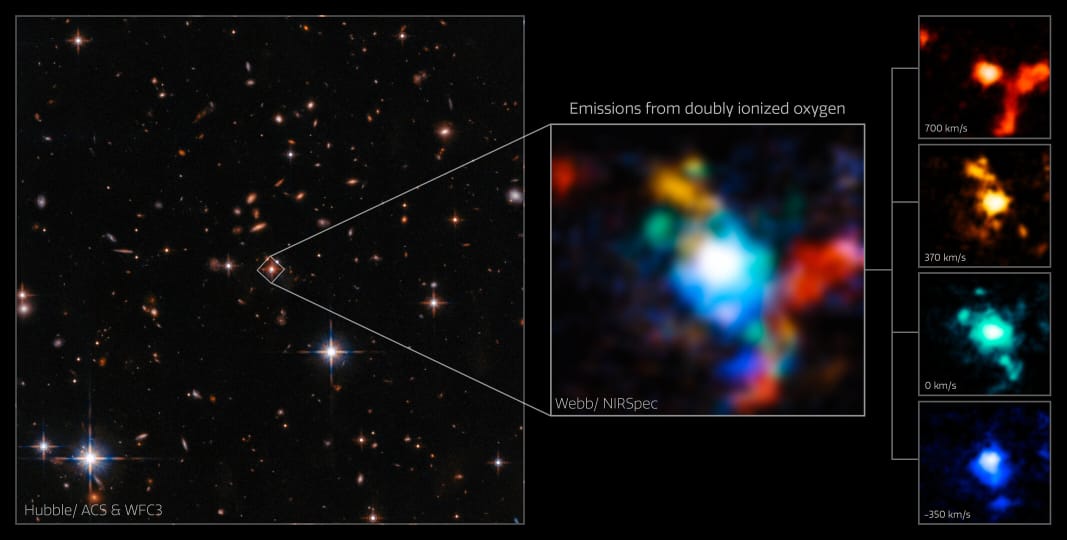Using NASA’s James Webb Space Telescope, astronomers studying the early universe have uncovered an unexpected discovery: a cluster of huge galaxies that are developing around an intensely red quasar.
Our comprehension of how galaxy clusters in the early universe came together and created the cosmic web we see today will be improved as a result of the research.
Active Galactic Nucleus (AGN)
A tight area with a supermassive black hole at the galaxy’s centre is known as a quasar, a particular kind of active galactic nucleus (AGN). The quasar is so bright that it outshines all of the stars in the galaxy as a result of gas falling into a supermassive black hole.
11.5 billion years ago, a quasar by the name of SDSS J165202.64+172852.3 was there. Not only is it naturally red, but the light from the galaxy has been red shifted due to its great distance, making it unusually red. This made Webb, who has the best infrared sensitivity, the ideal candidate to study the galaxy in depth.
Significance Of This Galactic Nuclei
One of the most potent galactic nuclei ever observed at such a great distance is this quasar. Scientists had hypothesized that the quasar’s intense emission might produce a “galactic wind,” which would force free gas out of its host galaxy and perhaps have a significant impact on future star formation there.
The researchers used the telescope’s Near Infrared Spectrograph to look into the motion of the gas, dust, and star material in the galaxy (NIRSpec). This sophisticated device examines the motion of numerous outflows and winds surrounding the quasar using a method known as spectroscopy.
Instead of only collecting spectra from one spot at a time, NIRSpec can collect spectra from the whole field of view of the telescope, allowing Webb to simultaneously study the quasar, its galaxy, and the larger environment.
Tracking The Motions Of Surrounding Materials
The quasar’s strong outflows were previously noted by NASA’s Hubble Space Telescope and other observatories, and astronomers conjectured that its host galaxy might be merging with an unidentified companion.
However, the researchers did not anticipate that Webb’s NIRSpec data would show that there were at least three other galaxies spinning around it, not just one.
The motions of all this surrounding material could be tracked thanks to spectra covering a wide area, which led to the discovery that the red quasar was in fact a component of a dense knot of galaxy formation.
“At this early stage, few galaxy proto clusters are known. The study was co-led by astronomer Dominika Wylezalek of Heidelberg University in Germany and cosmologist Stephen Webb. “It’s hard to find them, and very few have had time to form since the big bang,” Wylezalek said. “This could someday aid our understanding of the evolution of galaxies in crowded environments. It’s a promising outcome.”
Three Galactic Companions Of Quasar
The team was able to confirm three galactic companions to this quasar and demonstrate how they are connected using the images from NIRSpec. Hubble archived data suggest that there might be much more.
The quasar was chosen for this investigation of its outflow and the repercussions on its host galaxy because images from Hubble’s Wide Field Camera 3 had indicated extended material surrounding the quasar and its galaxy.
The team now believes they may have been viewing the center of an entire cluster of galaxies, which has only recently been made visible by Webb’s precise photography.
“We rapidly saw from our initial analysis of the data that there had been significant interactions with the nearby galaxies, according to team member Andrey Vayner of Johns Hopkins University in Baltimore, Maryland. We are in a new era of infrared spectroscopy, and the sensitivity of the NIRSpec device was instantly obvious.”
Densest Known Regions Of Galaxy Formation In The Early Cosmos
The fact that the three verified galaxies are orbiting one another at such high speeds suggests that a significant amount of matter is there. The team thinks this is one of the densest known regions of galaxy formation in the early cosmos because of how densely they are clustered in the area surrounding this quasar.
Wylezalek claims that even a tight knot of dark matter is insufficient to account for it. “We believe we may be observing an area where two enormous dark matter halos are fusing together.” It is believed that dark matter, an unobservable element of the cosmos, forms a “halo” around these stars, holding galaxies and galaxy clusters together.
Webb’s Study Of The Early Universes
The research by Wylezalek’s team is a component of Webb’s early universe studies. The telescope is already being used to study how the first galaxies began and evolved, as well as how black holes emerged and affected the structure of the universe, thanks to its unmatched ability to see back in time.
Follow-up observations into this surprising galaxy proto-cluster are being planned by the researchers in an effort to learn more about how dense, chaotic galaxy clusters like this one emerge and how the active, supermassive black hole at its centre affects them.
These findings are going to be printed in The Astrophysical Journal Letters. As a part of Webb’s Early Release Science programme, this study was done.
